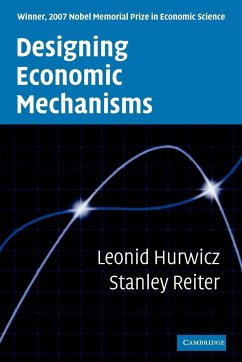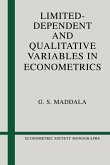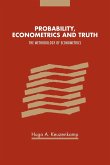- Broschiertes Buch
- Merkliste
- Auf die Merkliste
- Bewerten Bewerten
- Teilen
- Produkt teilen
- Produkterinnerung
- Produkterinnerung
A hot topic which can be used in economics, operations research and applied mathematics.
Andere Kunden interessierten sich auch für
![The Theory of General Economic Equilibrium The Theory of General Economic Equilibrium]() Andreu Mas-ColellThe Theory of General Economic Equilibrium104,99 €
Andreu Mas-ColellThe Theory of General Economic Equilibrium104,99 €![Forecasting Economic Time Series Forecasting Economic Time Series]() Michael ClementsForecasting Economic Time Series44,99 €
Michael ClementsForecasting Economic Time Series44,99 €![Economic Value of Weather and Climate Forecasts Economic Value of Weather and Climate Forecasts]() R. KatzEconomic Value of Weather and Climate Forecasts51,99 €
R. KatzEconomic Value of Weather and Climate Forecasts51,99 €![Impact Evaluation Impact Evaluation]() Markus FrölichImpact Evaluation52,99 €
Markus FrölichImpact Evaluation52,99 €![Essays in Panel Data Econometrics Essays in Panel Data Econometrics]() Marc NerloveEssays in Panel Data Econometrics78,99 €
Marc NerloveEssays in Panel Data Econometrics78,99 €![Limited-Dependent and Qualitative Variables in Econometrics Limited-Dependent and Qualitative Variables in Econometrics]() G. S. MaddalaLimited-Dependent and Qualitative Variables in Econometrics44,99 €
G. S. MaddalaLimited-Dependent and Qualitative Variables in Econometrics44,99 €![Probability, Econometrics and Truth Probability, Econometrics and Truth]() Hugo A. KeuzenkampProbability, Econometrics and Truth38,99 €
Hugo A. KeuzenkampProbability, Econometrics and Truth38,99 €-
-
-
A hot topic which can be used in economics, operations research and applied mathematics.
Hinweis: Dieser Artikel kann nur an eine deutsche Lieferadresse ausgeliefert werden.
Hinweis: Dieser Artikel kann nur an eine deutsche Lieferadresse ausgeliefert werden.
Produktdetails
- Produktdetails
- Verlag: Cambridge University Press
- Seitenzahl: 356
- Erscheinungstermin: 25. November 2010
- Englisch
- Abmessung: 229mm x 152mm x 21mm
- Gewicht: 578g
- ISBN-13: 9780521724104
- ISBN-10: 0521724104
- Artikelnr.: 23542319
- Herstellerkennzeichnung
- Books on Demand GmbH
- In de Tarpen 42
- 22848 Norderstedt
- info@bod.de
- 040 53433511
- Verlag: Cambridge University Press
- Seitenzahl: 356
- Erscheinungstermin: 25. November 2010
- Englisch
- Abmessung: 229mm x 152mm x 21mm
- Gewicht: 578g
- ISBN-13: 9780521724104
- ISBN-10: 0521724104
- Artikelnr.: 23542319
- Herstellerkennzeichnung
- Books on Demand GmbH
- In de Tarpen 42
- 22848 Norderstedt
- info@bod.de
- 040 53433511
Leonid Hurwicz is Regents' Professor of Economics Emeritus at the University of Minnesota. Internationally renowned for his pioneering research on economic theory, particularly in the areas of mechanism and institutional design and mathematical economics, he received the national Medal of Science in 1990. A member of the National Academy of Sciences and the American Academy of Arts and Sciences, Professor Hurwicz is a former President and Fellow of the Econometric Society. The recipient of six honorary doctorates, he serves on the editorial board of several journals and coedited and contributed to two collections for Cambridge University Press, Studies in Resource Allocation Processes (1978, with Kenneth Arrow) and Social Goals and Social Organization (1987, with David Schmeidler and Hugo Sonnenschein). His recent publications include papers in Economic Theory (2003, with Thomas Marschak), Review of Economic Design (2001, with Stanley Reiter), and Advances in Mathematical Economics (2003, with Marcel K. Richter).
1. Mechanisms and mechanism design
1.1. Introduction to mechanisms and mechanism design
1.2. Environments and goal functions
1.3. Mechanisms: message exchange processes and game forms
1.4. Initial dispersion of information and privacy preservation
1.5. Mechanism design
1.6. Mechanism design Illustrated in a Walrasian example
1.7. The rectangles method applied to the Walrasian goal function-informal
1.8. Introductory discussion of informational efficiency concepts
1.9. Regulation of logging in a national forest - an example of mechanism design
2. From goals to means: constructing mechanisms
2.1. Mechanism construction: phase one
2.2. Phase two: constructing decentralized
2.3.1. Flagpoles-principles
2.4.1. Phase two: via condensation: principles
2.5. Overlaps
2.6.1
Main results
3. Designing informationally efficient mechanisms using the language of aets
3.1. Introduction
3.2. Mechanism design
3.3. Mechanisms and coverings
3.4. A systematic process (an algorithm) for constructing and rRM covering
3.5
Transversals
3.6. Coverings and partitions
3.7. Informational efficiency
3.8. Example 1.9 revisited - a graphical presentation
3.9. Informationally efficient mechanisms with strategic behavior
4. Revelation mechanisms (co-authored with Kenneth R. Mount)
4.1. Introduction
4.2. Initial set theoretic constructions
4.3. The topological case
4.4. Proofs and examples.
1.1. Introduction to mechanisms and mechanism design
1.2. Environments and goal functions
1.3. Mechanisms: message exchange processes and game forms
1.4. Initial dispersion of information and privacy preservation
1.5. Mechanism design
1.6. Mechanism design Illustrated in a Walrasian example
1.7. The rectangles method applied to the Walrasian goal function-informal
1.8. Introductory discussion of informational efficiency concepts
1.9. Regulation of logging in a national forest - an example of mechanism design
2. From goals to means: constructing mechanisms
2.1. Mechanism construction: phase one
2.2. Phase two: constructing decentralized
2.3.1. Flagpoles-principles
2.4.1. Phase two: via condensation: principles
2.5. Overlaps
2.6.1
Main results
3. Designing informationally efficient mechanisms using the language of aets
3.1. Introduction
3.2. Mechanism design
3.3. Mechanisms and coverings
3.4. A systematic process (an algorithm) for constructing and rRM covering
3.5
Transversals
3.6. Coverings and partitions
3.7. Informational efficiency
3.8. Example 1.9 revisited - a graphical presentation
3.9. Informationally efficient mechanisms with strategic behavior
4. Revelation mechanisms (co-authored with Kenneth R. Mount)
4.1. Introduction
4.2. Initial set theoretic constructions
4.3. The topological case
4.4. Proofs and examples.
1. Mechanisms and mechanism design
1.1. Introduction to mechanisms and mechanism design
1.2. Environments and goal functions
1.3. Mechanisms: message exchange processes and game forms
1.4. Initial dispersion of information and privacy preservation
1.5. Mechanism design
1.6. Mechanism design Illustrated in a Walrasian example
1.7. The rectangles method applied to the Walrasian goal function-informal
1.8. Introductory discussion of informational efficiency concepts
1.9. Regulation of logging in a national forest - an example of mechanism design
2. From goals to means: constructing mechanisms
2.1. Mechanism construction: phase one
2.2. Phase two: constructing decentralized
2.3.1. Flagpoles-principles
2.4.1. Phase two: via condensation: principles
2.5. Overlaps
2.6.1
Main results
3. Designing informationally efficient mechanisms using the language of aets
3.1. Introduction
3.2. Mechanism design
3.3. Mechanisms and coverings
3.4. A systematic process (an algorithm) for constructing and rRM covering
3.5
Transversals
3.6. Coverings and partitions
3.7. Informational efficiency
3.8. Example 1.9 revisited - a graphical presentation
3.9. Informationally efficient mechanisms with strategic behavior
4. Revelation mechanisms (co-authored with Kenneth R. Mount)
4.1. Introduction
4.2. Initial set theoretic constructions
4.3. The topological case
4.4. Proofs and examples.
1.1. Introduction to mechanisms and mechanism design
1.2. Environments and goal functions
1.3. Mechanisms: message exchange processes and game forms
1.4. Initial dispersion of information and privacy preservation
1.5. Mechanism design
1.6. Mechanism design Illustrated in a Walrasian example
1.7. The rectangles method applied to the Walrasian goal function-informal
1.8. Introductory discussion of informational efficiency concepts
1.9. Regulation of logging in a national forest - an example of mechanism design
2. From goals to means: constructing mechanisms
2.1. Mechanism construction: phase one
2.2. Phase two: constructing decentralized
2.3.1. Flagpoles-principles
2.4.1. Phase two: via condensation: principles
2.5. Overlaps
2.6.1
Main results
3. Designing informationally efficient mechanisms using the language of aets
3.1. Introduction
3.2. Mechanism design
3.3. Mechanisms and coverings
3.4. A systematic process (an algorithm) for constructing and rRM covering
3.5
Transversals
3.6. Coverings and partitions
3.7. Informational efficiency
3.8. Example 1.9 revisited - a graphical presentation
3.9. Informationally efficient mechanisms with strategic behavior
4. Revelation mechanisms (co-authored with Kenneth R. Mount)
4.1. Introduction
4.2. Initial set theoretic constructions
4.3. The topological case
4.4. Proofs and examples.








